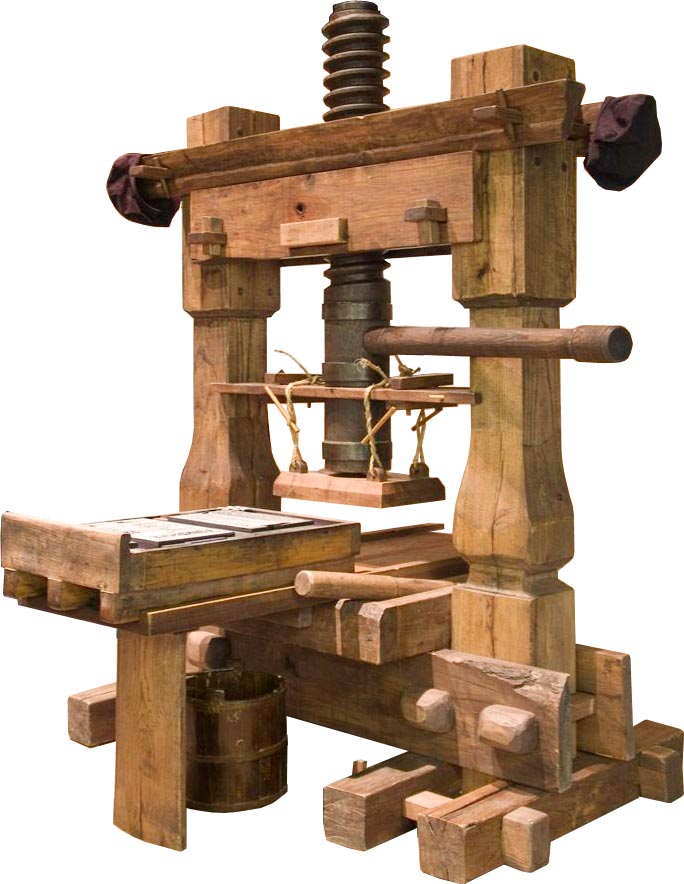Johannes Gutenberg was a German goldsmith and metal worker. He was the first to develop the printing press (movable type) in 1452. Gutenberg’s invention opened the floodgates of information and innovation. The printing press helped usher in the Renaissance, the scientific revolution, the Age of Enlightenment and social reformation. As Wendell Phillips observed, “What gunpowder did for war, the printing press has done for the mind.” One of the immediate benefits of the printing press was the dissemination of ideas to many. For the first time, literature was accessible to the masses.
Before the invention of the printing press books were expensive and available only to the privileged elite. It was difficult and an expensive task to hand-scribe each book. However, with the invention of the printing press, creating nearly identical books of quality at an economical price, books were now more affordable and available to the general public. Mass production of books and print, provoked contemplation and curiosity. With accessibility to knowledge came the desire to understand, leading to a rise in literacy for the common people. “It is estimated that by 1500 there were fifteen to twenty million copies of 30,000 to 35,000 separate publications.” (McLuhan, 1962, p.207) As Victor Hugo once said, “To learn to read is to light a fire; every syllable that is spelled out is a spark.”
Gutenberg’s discovery also powered the scientific revolution. The ability to print and disseminate scientific theories, information and experimental data was now able to be shared with a wider audience. This event allowed science to take great leaps in the sixteenth and seventeenth centuries. Scientists could aggregate research and share observations with a wider audience. The fidelity of existing data, formulas and mathematical tables provided an opportunity for scientists to devote more energy and mental faculties to new discoveries and inventions. Gutenberg’s printing press affected science significantly, providing scientists such as Galileo, Pascal, and Newton a revolutionary way to set up an empirical body of knowledge. While academia benefitted and progressed significantly, important change was also seen in the public sector. The printing press provided an invaluable platform for social progress. A new culture of ideas liberated the rigidity of thought. The social constraints of society, which dictated thought and reasoning lost its grip on an ignorant and unlearned society. Uncensored literature, opinions, and thoughts were unleashed.
Up to this point, the main influences on society were culture, the church and the state, leaving little to no room for reference, learning, debate or ideological ponderings. Those who opposed the status quo or dared independent thought, were quickly silenced, often at the stake. The printing press introduced a new stream for sharing information. Dissemination of ideas was much more expedient and efficient. New and fringe ideas became accessible on a much larger scale. It became nearly impossible to destroy all copies of a dangerous idea, a protest of the establishment or an historical precedent. This event ensured that the masses could receive information before it was audited or controlled by an authoritative over-see, such as the Catholic church or the governing party. Printing technology traveled quickly across Europe and transformed the success of the Protestant Reformation.
When Martin Luther nailed his Ninety-Five Theses to the door of the Wittenberg Church on October 31, 1517, he was calling for a disputation concerning indulgences.With the use of the printing press, Luther was able to dispense his pamphlets on a wide scale and made it difficult for the Catholic church to inhibit the spread of what it regarded as heretical ideas. The Ninety-Five Theses caused such an outrage that the subsequent protest of the Catholic Church was the basis of the Protestant Reformation. The ability of movable type printing and for duplicating the document quickly, allowed Luther’s reforming work to pave the way to independent thought, social and religious freedoms and to set a precedent for other reformers.
In conclusion, the printing press is so important that it is known as one of the most valuable inventions of our time. It drastically changed the way society emerged. The advances in the Early Modern era would have been inconceivable without the invention of Gutenberg’s printing press. This powerful innovation provided a means for dynamic scientific advances, substantial societal enlightenment and the revolution of ideas. Knowledge expanded perceptions to include a new culture of theory, thought and social progress. The printing press initiated an information revolution much the same as the Internet today. Gutenberg’s contribution provided a formidable foundation from which future generations would continue to benefit from freedom of thought and shared ideas.
http://blogs.ubc.ca/etec540sept10/page/15/ http://blogs.ubc.ca/etec540sept10/page/15/ http://www.readsaskatoon.com/blog/posts/leaving_a_legacy.html https://www.reformation21.org/articles/the-importance-of-the-printing-press-for-the-protestant-reformation-part-two.php https://www.reformation21.org/articles/the-importance-of-the-printing-press-for-the-protestant-reformation-part-two.php http://blogs.ubc.ca/etec540sept10/page/15/ Work Cited: Renner, Rebecca. “Reasons Why the Printing Press Was a Great Invention.” The Classroom | Empowering Students in Their College Journey, 10 Jan. 2019, http://www.theclassroom.com/reasons-printing-press-great-invention-6116.html. History.com Editors. “Printing Press.” History.com, A&E Television Networks, 7 May 2018, http://www.history.com/topics/inventions/printing-press. Historyguide.org, http://www.historyguide.org/intellect/press.html. Palermo, Elizabeth. “Who Invented the Printing Press?” LiveScience, Purch, 25 Feb. 2014, http://www.livescience.com/43639-who-invented-the-printing-press.html. Villiers, Nicole de, et al. “1400 - 1499: The History of Printing during the 15th Century.” Prepressure, http://www.prepressure.com/printing/history/1400-1499. “The Effect of the Printing Press in the Renaissance in the 15th Century, Italy.” ETEC540 Text Technologies, blogs.ubc.ca/etec540sept10/2010/11/09/the-effect-of-the-printing-press-in-the-renaissance-in-the-15th-century-italy/. “The Renaissance: the Invention of the Printing Press.” Free Essays - PhDessay.com, 27 Mar. 2020, phdessay.com/the-renaissance-the-invention-of-the-printing-press-and-its-effects/.
